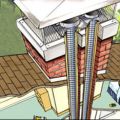FIREPLACE SERVICE

Did you ever hear of a “hearth professional?” the hearth professional is a person who has been certified by the National Fireplace Institute (NPI), the professional certification division of the Hearth, Patio, and Barbecue Education Foundation (HPBEF) of Arlington, VA, a non-profit educational entity.
The NPI offers educational and certification procedures leading to the title of Master Hearth Professional, composed of certifications for specialists involved with gas burning appliances, wood burning appliances, and pellet burning appliances. Their raison d’être is public safety.
Competent installation and servicing, including repair, is very important. It is also important to recognize that there are size, type, and feature of the various appliances that are installed. The specific fuels used and the configuration of the venting system of your fireplace become important, as well.
Elements of Fireplace Service
The question must be asked: when we discuss servicing a fireplace, are we talking installation, repair, or merely monitoring. There is a one-word answer to the question: Yes.
Fireplace service should happen at least annually, and, of course, prior to the heating season. These are the steps:
• The process starts with a chimney inspection, where a knowledgeable fireplace professional must determine how contaminated the exhaust flues are. Chimney walls that are soot or creosote covered are a primary cause of chimney fires. Your fire insurance carrier will be very interested to know that this assessment has been done.
• If it is determined that the chimney is dirty, the next step is to employ a chimney sweeping service. A professional chimney sweeper will be aware of the various kinds of contaminants in the chimney and have the necessary chemicals and tools to remove them.
• Once the chimney is clean, a determination must be made regarding the need for any masonry repair. At this point, if deficiencies are found, these tasks must be done:
• Chimney rebuilding. This is done only if the chimney is in such sad state of repair that there is a fire hazard present that should prevent additional use. Sometimes that portion of the chimney that has been exposed to the weather may need to be replaced “from the roof up.” A fireplace service must have qualified masons available to do that work.
• Chimney relining. Nowadays, chimneys are built with liners—tile, ceramic, or metal. That’s simply the way they’re built now, and several entities mandate that construction—fire laws, insurance companies, or local ordinances. Older chimneys or others in need of internal repairs—including those that vent a fireplace—may need relining, and that should be done before the heating season begins.
• Exterior brick face and stone installation may require replacement of bricks (or stones) and mortar in response to the weathering placed upon the chimney.
• Pointing or repointingmay have to be done, either internally or externally. Technically, pointing the masonry involves the placement of mortar into joints to fill defects or bind newly prepared masonry.Repointing is what you must do when the masonry begins to fall apart. Here you will cut into or rake the joints to correct a joint made deficient or defective by the passage of time. A variation of these two is called tuck-pointing, which is largely a cosmetic procedure to distinguish the masonry color from the mortar color.
Firebox Considerations
In a masonry fireplace, a mason will use firebrick for the firebox—the place where the fire actually is built. These bricks are refractory and are bound using fireclay mortar, handling large heat loads. However, like all bricks, they can crack and crumble, creating a fire hazard.
Cracked fireboxes must be replaced or repaired. Patches are often acceptable, but new firebricks may need to be laid using refractory mortar. The same pointing, repointing, and tuck-pointing procedures used in any brickwork apply here, as well.
Other Considerations
Often a fireplace service will involve modifications to the use of the fireplace itself. Included in this will be the installation of wood burning, pellet, or gasstoves, including a gas fireplace or gas log appliances, even the addition of gas to an existing installation.
For More Info About Fireplace service Visit Us.
Source: Click Here




